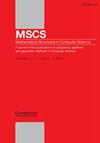Confluence of left-linear higher-order rewrite theories by checking their nested critical pairs
IF 0.9
4区 计算机科学
Q4 COMPUTER SCIENCE, THEORY & METHODS
引用次数: 3
Abstract
Abstract User-defined higher-order rewrite rules are becoming a standard in proof assistants based on intuitionistic type theory. This raises the question of proving that they preserve the properties of beta-reductions for the corresponding type systems. In a series of papers, we develop techniques based on van Oostrom’s decreasing diagrams that reduce confluence proofs to the checking of various forms of critical pairs for higher-order rewrite rules extending beta-reduction on pure lambda-terms. As shown in a previous paper of the two middle authors, confluence of a terminating set of left-linear rewrite rules is obtained when their critical pairs are joinable, beta-rewrite steps being disallowed. The present paper concentrates on the case where arbitrary beta-rewrite steps are allowed for joining critical pairs. The rewrite relation used for analyzing confluence may rewrite arbitrarily many non-overlapping redexes in a single step. This relation gives rise to critical pairs that overlap both horizontally, as with parallel rewriting, but also vertically, forming chains of successive overlaps. Practical examples of use of this technique are analyzed.用嵌套临界对检验左线性高阶重写理论的合流性
摘要用户定义的高阶重写规则正在成为基于直觉类型理论的证明助手的标准。这就提出了一个问题,即证明它们保留了相应类型系统的贝塔约简的性质。在一系列论文中,我们开发了基于van Oostrom递减图的技术,这些技术将汇流证明简化为检查各种形式的临界对,以用于在纯lambda项上扩展贝塔约简的高阶重写规则。正如两位中间作者之前的一篇论文所示,当左线性重写规则的关键对是可连接的,不允许贝塔重写步骤时,可以获得左线性重写的终止集的汇合。本文集中讨论了允许任意贝塔重写步骤来连接关键对的情况。用于分析合流的重写关系可以在一个步骤中重写任意多个不重叠的redex。这种关系产生了临界对,它们既在水平方向重叠,就像平行重写一样,也在垂直方向重叠,形成连续重叠的链。分析了该技术的应用实例。
本文章由计算机程序翻译,如有差异,请以英文原文为准。
求助全文
约1分钟内获得全文
求助全文
来源期刊

Mathematical Structures in Computer Science
工程技术-计算机:理论方法
CiteScore
1.50
自引率
0.00%
发文量
30
审稿时长
12 months
期刊介绍:
Mathematical Structures in Computer Science is a journal of theoretical computer science which focuses on the application of ideas from the structural side of mathematics and mathematical logic to computer science. The journal aims to bridge the gap between theoretical contributions and software design, publishing original papers of a high standard and broad surveys with original perspectives in all areas of computing, provided that ideas or results from logic, algebra, geometry, category theory or other areas of logic and mathematics form a basis for the work. The journal welcomes applications to computing based on the use of specific mathematical structures (e.g. topological and order-theoretic structures) as well as on proof-theoretic notions or results.
 求助内容:
求助内容: 应助结果提醒方式:
应助结果提醒方式:


